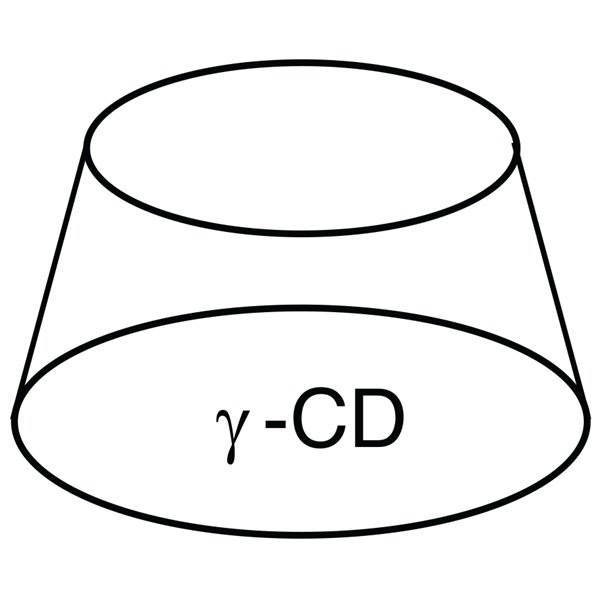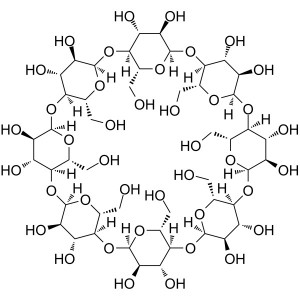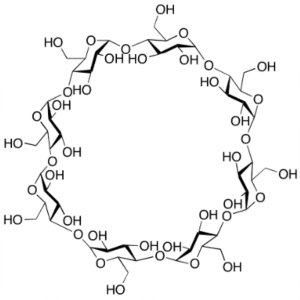γ-Cyclodextrin (γ-CD) CAS 17465-86-0 Assay 98.0~102.0%
Ruifu Chemical is the leading manufacturer of γ-Cyclodextrin (γ-CD) (CAS: 17465-86-0) with high quality. Ruifu Chemical supplies pharma grade cyclodextrins. Ruifu Chemical can provide worldwide delivery, competitive price, small and bulk quantities available. Purchase γ-Cyclodextrin, Please contact: alvin@ruifuchem.com
| Chemical Name | γ-Cyclodextrin |
| Synonyms | γ-CD; gamma-Cyclodextrin; Cyclooctapentylose; Schardinger γ-Dextrin; Schardinger gamma-Dextrin; gamma-Schardinger Dextrin; Cavamax W8; Cyclooctaamylose; Cyclomaltooctaose |
| Stock Status | In Stock, Commercial Production |
| CAS Number | 17465-86-0 |
| Molecular Formula | C48H80O40 |
| Molecular Weight | 1,297.12 g/mol |
| Melting Point | ≥300℃ |
| Sensitive | Hygroscopic |
| Water Solubility | Soluble in Water |
| COA & MSDS | Available |
| Free Sample | Available |
| Origin | Shanghai, China |
| Category | Pharmaceutical Excipients; Food Additives |
| Shelf Life | 36 Months if Stored Properly |
| Brand | Ruifu Chemical |
| Items | Specifications | Results |
| Appearance | White or Almost White Amorphous or Crystalline Powder | Conforms |
| ldentification IR | Same Absorption Bands as Gamma Cyclodextrin RS | Conforms |
| ldentification HPLC | The retention time of the major peak of sample solution corresponds to the standard solution. | Conforms |
| Assay | 98.0%~102.0% (Calculated on the Dried Basis) | 99.3% |
| Specific Rotation [a]20/D | +174.0° to +180.0° | +175.2° |
| pH | 5.0~8.0 | 6.90 |
| Clarity & Color of Solution | 10mg/ml Water Solution is Clear and Colorless | Conforms |
| Light-Absorbing Impurities |
≤0.10 (230 nm~350 nm) ≤0.05 (350 nm~750 nm) | Conforms |
| Loss on Drying | ≤11.0% | 9.0% |
| Residue on Ignition | ≤0.10% | 0.07% |
| Heavy Metals | ≤5ppm | <5ppm |
| Reducing Substances | ≤0.50% | <0.20% |
| Related Substances | ||
| Alpha Cyclodextrin | ≤0.50% | None |
| Betadex Cyclodextrin | ≤0.50% | None |
| Sum of Other Impurities | ≤0.50% (HPLC) | None |
| Microbiological Test | ||
| Total Aerobic Microbial Counts | ≤1000cfu/g | ≤20cfu/g |
| Total Molds & Yeasts Counts | ≤100cfu/g | ≤10cfu/g |
| Escherichia Coli | Absent | Absent |
| Salmonella | Absent | Absent |
| Conclusion | The product has been tested and complies with the given specifications | |
Package: 1kg/Bag, 10kg/Cardboard Drum, 25kg/Cardboard Drum, or according to customer's requirement.
Storage Condition: Keep the container tightly closed and store in a cool, dry and well-ventilated warehouse away from incompatible substances. Protect from light and moisture. Cyclodextrins are stable in the solid state if protected from high humidity.
Shipping: Deliver to worldwide by air, by FedEx / DHL Express. Provide fast and reliable delivery.
Gamma Cyclodextrin
(C6H10O5)8 1297.12
Cyclooctaamylose;
Cyclomaltooctaose [17465-86-0].
DEFINITION
Gamma Cyclodextrin is composed of 8 alpha-(1–4) linked d-glycopyranosyl units. It contains NLT 98.0% and NMT 102.0% of cyclooctaamylose (C6H10O5)8, calculated on the dried basis.
IDENTIFICATION
• A. Infrared Absorption <197K>
• B. The retention time of the major peak from the Sample solution corresponds to that of the Standard solution, as obtained in the Assay.
• C. It meets the requirements of the test for Specific Rotation.
ASSAY
• Procedure
Mobile phase: Methanol and water (7:93)
System suitability solution: Prepare an aqueous solution containing 0.5 mg/mL each of USP Alpha Cyclodextrin RS, USP Beta Cyclodextrin RS, and USP Gamma Cyclodextrin RS.
Standard solution: 1.0 mg/mL of USP Gamma Cyclodextrin RS
Sample stock solution: Transfer 250 mg of Gamma Cyclodextrin to a 25-mL volumetric flask, and dissolve in water, with the aid of heat if necessary. Cool, and dilute with water to volume.
Sample solution: 1.0 mg/mL of Gamma Cyclodextrin, prepared from the Sample stock solution
Chromatographic system
(See Chromatography <621>, System Suitability.)
Mode: LC
Detector: Refractive index
Column: 4.6-mm × 15-cm; 5-µm packing L1
Temperature
Detector: 40
Column: 30
Flow rate: 1.5 mL/min
Injection size: 50 µL
System suitability
Sample: System suitability solution
[Note-The relative retention times for gamma cyclodextrin, alfadex, and betadex are 0.8, 1.0, and 1.9, respectively.]
Suitability requirements
Resolution: NLT 1.5 between the gamma cyclodextrin and alfadex peaks
Tailing factors: 0.8-2.0 for the three cyclodextrins
Relative standard deviation: NMT 2.0%
Analysis
Samples: Standard solution and Sample solution
Calculate the percentage of gamma cyclodextrin [(C6H10O5)8] in the portion of sample taken:
Result = (rU/rS) × (CS/CU) × 100
rU = peak response from the Sample solution
rS = peak response from the Standard solution
CS = concentration of the Standard solution (mg/mL)
CU = concentration of the Sample solution (mg/mL) corrected for water found in Specific Tests, Loss on Drying
Acceptance criteria: 98.0%-102.0% on the dried basis
IMPURITIES
• Residue on Ignition <281>: NMT 0.1%, determined on a 1.0-g specimen
• Heavy Metals, Method II <231>: NMT 5 ppm
• Related Compounds
Mobile phase, System suitability solution, and Chromatographic system: Proceed as directed in the Assay.
Standard solution: Transfer 5.0 mL of System suitability solution into a 50-mL volumetric flask, and dilute with water to volume.
Sample solution: Use the Sample stock solution, prepared as directed in the Assay.
Analysis
Samples: Standard solution and Sample solution
Acceptance criteria: For the Sample solution, the areas of any peaks corresponding to alfadex (alpha cyclodextrin) or to betadex (beta cyclodextrin) are not greater than the area of the corresponding peaks in the chromatogram of the Standard solution (0.5%); and the sum of the areas of all the peaks, excluding the principal peak, the peaks corresponding to alfadex or to betadex, and artifact peaks, is not greater than the area of the peak corresponding to gamma cyclodextrin in the chromatogram of the Standard solution (0.5%).
• Reducing Substances
Dextrose standard solution: 10.0 mg/mL of USP Dextrose RS, calculated on the anhydrous basis
Analysis: Transfer a quantity of Gamma Cyclodextrin, equivalent to 1.0 g on the dried basis, to a 500-mL conical flask. Dissolve in 10 mL of water, and add 25 mL of alkaline cupric citrate TS2. Cover the flask with aluminum foil, and boil the solution for 5 min. Cool in an ice bath to room temperature. Add 25 mL of 0.6 N acetic acid, 10 mL of 3 N hydrochloric acid, and 10 mL of 0.1 N iodine solution. [Note—The addition of these solutions must be in the order given.]
Titrate the solution with 0.1 N sodium thiosulfate VS, and determine the endpoint potentiometrically. Perform a blank determination (see Titrimetry 541, Residual Titrations). Calculate the difference in volumes required.
Create a calibration curve by similarly titrating 0.25, 0.5, 0.75, and 1.0 mL of Dextrose standard solution. Plot the amount, in mg, of dextrose in each titrated Dextrose standard solution versus the volume consumed, in mL, of 0.1 N sodium thiosulfate VS in the titration, and draw a straight line through the four points. From the line so obtained and the volume of 0.1 N sodium thiosulfate VS required in the titration of Gamma Cyclodextrin, determine the weight, W, in mg, of the reducing substances as dextrose in the portion of Gamma Cyclodextrin taken.
Calculate the percentage of the reducing substances in the portion of Gamma Cyclodextrin taken:
Result = (W/WG) × F × 100
W = weight of the reducing substances as dextrose in the portion of Gamma Cyclodextrin taken (mg)
WG = weight of Gamma Cyclodextrin taken (g)
F = conversion factor, 10-3 g/mg
Acceptance criteria: NMT 0.5%
SPECIFIC TESTS
• Microbial Enumeration Tests 61 and Tests for Specified Microorganisms 62: It meets the requirements of the tests for the absence of Salmonella species and Escherichia coli. The total aerobic microbial count does not exceed 1000 cfu/g, and the total combined molds and yeasts count does not exceed 100 cfu/g.
• Color and Clarity of Solution
Sample solution: Transfer a quantity of Gamma Cyclodextrin, equivalent to 2.5 g on the dried basis, into a 25-mL volumetric flask, dissolve in and dilute with water that has been previously boiled and cooled to room temperature to volume, and mix.
Analysis: Determine the absorbance of the Sample solution in a 1-cm cell at 420 nm, with a suitable spectrophotometer, after correcting for the blank.
Acceptance criteria: At 420 nm, the absorbance is not greater than 0.20, and the solution is clear.
• Loss on Drying 731: Dry a sample at 105 for 2 h: it loses NMT 11.0% of its weight.
• Optical Rotation, Specific Rotation <781S>
Sample solution: 10 mg/mL
Analysis: Proceed as directed in the chapter.
Acceptance criteria: +174 to +180
ADDITIONAL REQUIREMENTS
• Packaging and Storage: Preserve in well-closed containers, and store at room temperature.
• USP Reference Standards 11
USP Alpha Cyclodextrin RS Click to View Structure
USP Beta Cyclodextrin RS Click to View Structure
USP Dextrose RS Click to View Structure
USP Gamma Cyclodextrin RS Click to View Structure
How to Purchase? Please contact Dr. Alvin Huang: sales@ruifuchem.com or alvin@ruifuchem.com
15 Years Experience? We have more than 15 years of experience in the manufacture and export of a wide range of high quality pharmaceutical intermediates or fine chemicals.
Main Markets? Sell to domestic market, North America, Europe, India, Korea, Japanese, Australia, etc.
Advantages? Superior quality, affordable price, professional services and technical support, fast delivery.
Quality Assurance? Strict quality control system. Professional equipment for analysis include NMR, LC-MS, GC, HPLC, ICP-MS, UV, IR, OR, K.F, ROI, LOD, MP, Clarity, Solubility, Microbial limit test, etc.
Samples? Most products provide free samples for quality evaluation, shipping cost should be paid by customers.
Factory Audit? Factory audit welcome. Please make an appointment in advance.
MOQ? No MOQ. Small order is acceptable.
Delivery Time? If within stock, three days delivery guaranteed.
Transportation? By Express (FedEx, DHL), by Air, by Sea.
Documents? After sales service: COA, MOA, ROS, MSDS, etc. can be provided.
Custom Synthesis? Can provide custom synthesis services to best fit your research needs.
Payment Terms? Proforma invoice will be sent first after confirmation of order, enclosed our bank information. Payment by T/T (Telex Transfer), PayPal, Western Union, etc.
Hazard Symbols Xi - Irritant
Risk Codes 36/37/38 - Irritating to eyes, respiratory system and skin.
Safety Description
S26 - In case of contact with eyes, rinse immediately with plenty of water and seek medical advice.
S36 - Wear suitable protective clothing.
S24/25 - Avoid contact with skin and eyes.
S22 - Do not breathe dust.
WGK Germany 2
RTECS GU2293080
FLUKA BRAND F CODES 3
HS Code 3505100000
Cyclodextrins occur as white, practically odorless, fine crystalline powders, having a slightly sweet taste. Some cyclodextrin derivatives occur as amorphous powders. γ-Cyclodextrin (CAS:17465-86-0) is one of the three common forms of Cyclodextrins. The compound is composed of eight glucose units and forms the shape of a hollow truncated cone with a hydrophylic exterior and hydrophobic interior. Due to the larger number of glucose units the compound is more favored than the α-Cyclodextrin (CAS: 10016-20-3) and β-Cyclodextrin (CAS: 7585-39-9) counterparts and can form inclusion bodies with steroids and macrocycles. Due to γ-Cyclodextrin flexibility and non-coplanar structure the compound has a solubility of 232 g/L, 25°C. The compound can also be digested with both salivary and pancreatic amylase unlike α-Cyclodextrin and β-Cyclodextrin.
The Cyclodextrin has a hole in the center of the ring structure. There is an oxygen atom bound by - CH - and glucoside inside, which is sulfur water-based. The - OH groups at positions 2, 3 and 6 of glucose are hydrophilic. Other molecules can be complexed to form inclusion complexes through weak van der Waals force. There are many substances that can be included by cyclodextrins, including rare gases, halogens, dyes, spices, drugs, food, pesticides and preservatives. After encapsulation, its stability, volatility, solubility and reactivity were improved. The special function of cyclodextrin makes it an inclusion material with wide application value.
1. Use in the pharmaceutical industry: Cyclodextrin can form inclusion complexes (encapsulation) with drugs, which can stabilize (1) Unstable drugs; (2) Deliquescence, adhesion or powdering of liquid drugs; (3) Insoluble or insoluble drugs can be dissolved (solubilized), etc.
2. Application in the pesticide industry: Cyclodextrin inclusion stabilization, while some pesticides can be stored and improve the insecticidal efficacy.
3. Use in the food industry: Cyclodextrin is used in the food industry and has the following functions: (1) Elimination and masking of special odor; (2) Improvement and improvement of food organization structure; (3) The reduction and removal of bitter taste; (4) Antioxidant effect; (5) Maintain and optimize flavor.
4. Use in daily chemical industry: Cyclodextrin can also be used as emulsifier and quality improver in cosmetics manufacturing. It also has deodorization (such as removing bad breath) and antiseptic effects, and can be used for the manufacture of toothpaste and tooth powder.
5. Other uses: it can be used as a treatment agent for oily sewage in environmental protection. The aqueous solution of Cyclodextrin is used to clean the oil tank, and the waste liquid can be recycled to obtain fuel oil.
6. Use of Cyclodextrin in the chemical field: Cyclodextrin is a valuable chemical reagent. When it is present, the fluorescence intensity of fluorescent pigment will increase significantly, so it can be used for the analysis of protein and amino acid; It can also be used to separate long-chain organic compounds and racemates. In addition, the adsorbent made of Cyclodextrin can be used as adsorption for chromatographic analysis. It can also be used as a complexing agent, enzyme activity research, tissue culture agent. This product should be sealed in a dry place.
γ-Cyclodextrin (γ-CD) (CAS: 17465-86-0)
A. In food industry aspect:
(1) It can exclude bitter taste and smell.
(2) It can improve and construction of food.
(3) It can inhibit the finished products oxidation.
(4) It can keep the flavor and taste last long.
B. In daily chemical industry aspect:
It could used as emulsification and modifier. Also it can eliminate odour and corrosion in toothpaste.
C. In pharmaceutical industry aspect:
It is mainly used to strengthen the stability of the medicine,
It can increase the solubility of the medicine,
It can reduce the toxicity of it and cover up the odor and smell from it.
Cyclodextrins are ‘bucketlike’ or ‘conelike’ toroid molecules, with a rigid structure and a central cavity, the size of which varies according to the cyclodextrin type. The internal surface of the cavity is hydrophobic and the outside of the torus is hydrophilic; this is due to the arrangement of hydroxyl groups within the molecule. This arrangement permits the cyclodextrin to accommodate a guest molecule within the cavity, forming an inclusion complex.
Cyclodextrins may be used to form inclusion complexes with a variety of drug molecules, resulting primarily in improvements to dissolution and bioavailability owing to enhanced solubility and improved chemical and physical stability.
Cyclodextrin inclusion complexes have also been used to mask the unpleasant taste of active materials and to convert a liquid substance into a solid material. γ-cyclodextrin has the largest cavity and can be used to form inclusion complexes with large molecules;it has low toxicity and enhanced water solubility.
In parenteral formulations, cyclodextrins have been used to produce stable and soluble preparations of drugs that would otherwise have been formulated using a nonaqueous solvent.
In eye drop formulations, cyclodextrins form water-soluble complexes with lipophilic drugs such as corticosteroids. They have been shown to increase the water solubility of the drug; to enhance drug absorption into the eye; to improve aqueous stability; and to reduce local irritation.
Cyclodextrins have also been used in the formulation of solutions,suppositories, and cosmetics.
Included in the FDA Inactive Ingredients Database: α-Cyclodextrin (injection preparations); β-Cyclodextrin (oral tablets, topical gels); γ-Cyclodextrin (IV injections).
Included in the Canadian List of Acceptable Non-medicinal Ingredients (stabilizing agent; solubilizing agent ); and in oral and rectal pharmaceutical formulations licensed in Europe, Japan, and the USA.
-
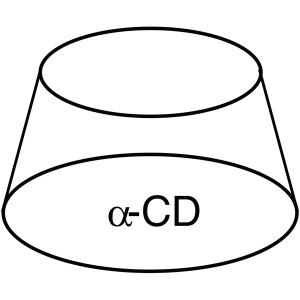
α-Cyclodextrin (α-CD) CAS 10016-20-3 Pharmaceut...
-
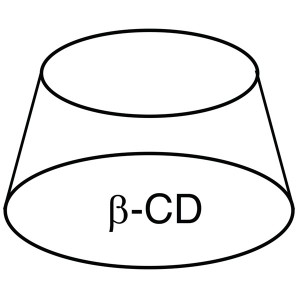
β-Cyclodextrin (β-CD) CAS 7585-39-9 Assay 98.0%...
-
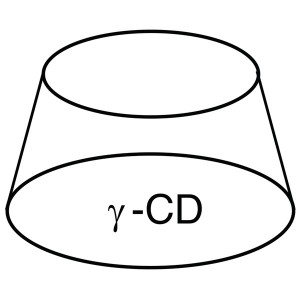
γ-Cyclodextrin (γ-CD) CAS 17465-86-0 Assay 98.0...
-
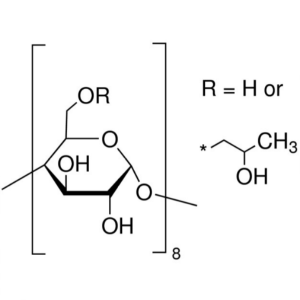
(2-Hydroxypropyl)-γ-Cyclodextrin CAS 128446-34-...
-
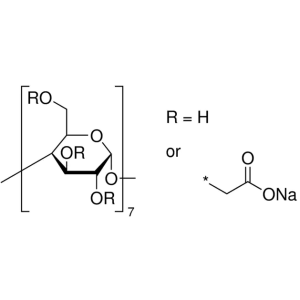
Carboxymethyl-β-Cyclodextrin CAS 218269-34-2 (C...
-
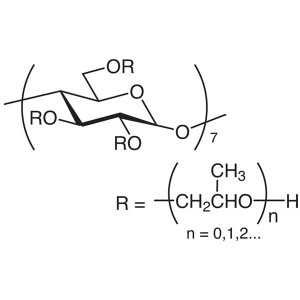
Hydroxypropyl-β-Cyclodextrin CAS 128446-35-5 (H...
-
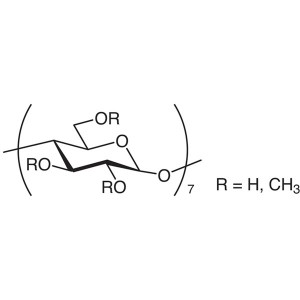
Methyl-β-Cyclodextrin CAS 128446-36-6 (Me-β-CD)
-
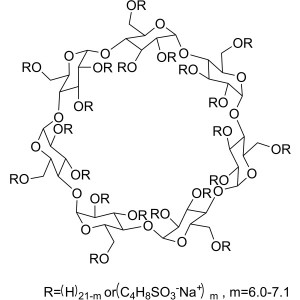
SBE-β-CD CAS 182410-00-0 Betadex Sulfobutyl Eth...

